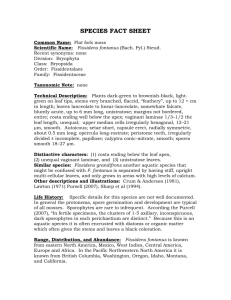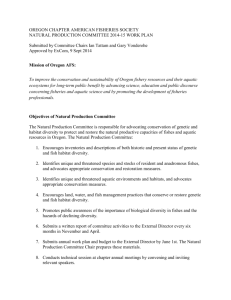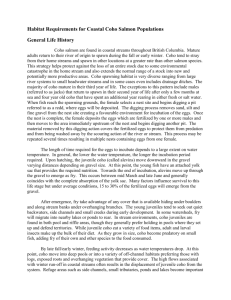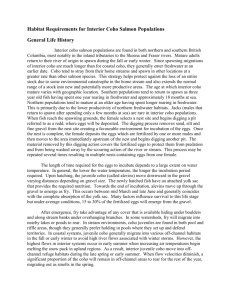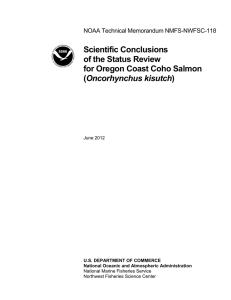The Habitat Limiting Factors Model
advertisement
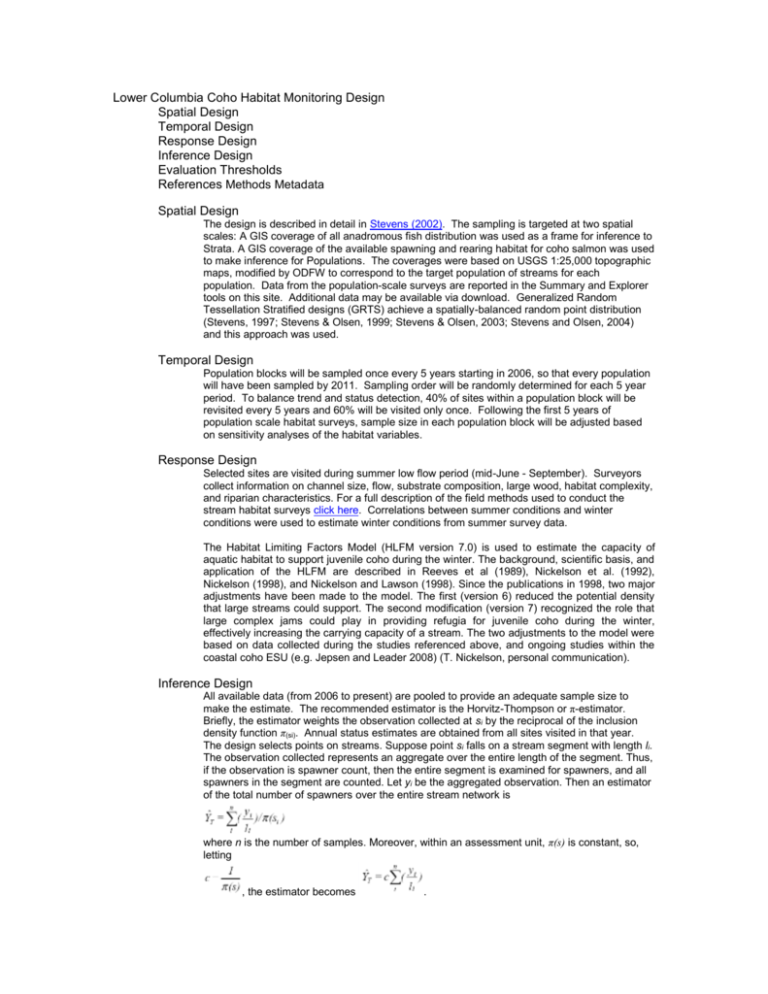
Lower Columbia Coho Habitat Monitoring Design Spatial Design Temporal Design Response Design Inference Design Evaluation Thresholds References Methods Metadata Spatial Design The design is described in detail in Stevens (2002). The sampling is targeted at two spatial scales: A GIS coverage of all anadromous fish distribution was used as a frame for inference to Strata. A GIS coverage of the available spawning and rearing habitat for coho salmon was used to make inference for Populations. The coverages were based on USGS 1:25,000 topographic maps, modified by ODFW to correspond to the target population of streams for each population. Data from the population-scale surveys are reported in the Summary and Explorer tools on this site. Additional data may be available via download. Generalized Random Tessellation Stratified designs (GRTS) achieve a spatially-balanced random point distribution (Stevens, 1997; Stevens & Olsen, 1999; Stevens & Olsen, 2003; Stevens and Olsen, 2004) and this approach was used. Temporal Design Population blocks will be sampled once every 5 years starting in 2006, so that every population will have been sampled by 2011. Sampling order will be randomly determined for each 5 year period. To balance trend and status detection, 40% of sites within a population block will be revisited every 5 years and 60% will be visited only once. Following the first 5 years of population scale habitat surveys, sample size in each population block will be adjusted based on sensitivity analyses of the habitat variables. Response Design Selected sites are visited during summer low flow period (mid-June - September). Surveyors collect information on channel size, flow, substrate composition, large wood, habitat complexity, and riparian characteristics. For a full description of the field methods used to conduct the stream habitat surveys click here. Correlations between summer conditions and winter conditions were used to estimate winter conditions from summer survey data. The Habitat Limiting Factors Model (HLFM version 7.0) is used to estimate the capacity of aquatic habitat to support juvenile coho during the winter. The background, scientific basis, and application of the HLFM are described in Reeves et al (1989), Nickelson et al. (1992), Nickelson (1998), and Nickelson and Lawson (1998). Since the publications in 1998, two major adjustments have been made to the model. The first (version 6) reduced the potential density that large streams could support. The second modification (version 7) recognized the role that large complex jams could play in providing refugia for juvenile coho during the winter, effectively increasing the carrying capacity of a stream. The two adjustments to the model were based on data collected during the studies referenced above, and ongoing studies within the coastal coho ESU (e.g. Jepsen and Leader 2008) (T. Nickelson, personal communication). Inference Design All available data (from 2006 to present) are pooled to provide an adequate sample size to make the estimate. The recommended estimator is the Horvitz-Thompson or π-estimator. Briefly, the estimator weights the observation collected at si by the reciprocal of the inclusion density function π(si). Annual status estimates are obtained from all sites visited in that year. The design selects points on streams. Suppose point si falls on a stream segment with length li. The observation collected represents an aggregate over the entire length of the segment. Thus, if the observation is spawner count, then the entire segment is examined for spawners, and all spawners in the segment are counted. Let yi be the aggregated observation. Then an estimator of the total number of spawners over the entire stream network is where n is the number of samples. Moreover, within an assessment unit, π(s) is constant, so, letting , the estimator becomes . Refer to epa.gov/nheerl/arm for R scripts (spsurvey library; function CDF.compute) to calculate cumulative distribution functions (cdf) population estimates and confidence intervals. An error estimate of the miles of high quality habitat in each population unit is based on the 95% confidence interval of the cumulative distribution function (cdf) for winter parr. The point estimate of high quality miles and 95% C.I. is estimated at a value of 1850 parr/km on the CDF. Evaluation Thresholds Pass – The number of additional/new miles of high quality miles habitat (as determined by ODFW’s Habitat Limiting Factors Model) equals or exceeds the threshold. Fail – The number of additional/new miles of high quality miles habitat (as determined by ODFW’s Habitat Limiting Factors Model) is less than the threshold. Miles of high quality habitat needed to achieve delisting and broad sense recovery abundance goals for coho. Miles of High Quality Habitat Population Youngs Bay Delisting Broad Sense 1.5 137 Big Creek 11.4 87.4 Clatskanie 19 19 Scappoose 10 24 Clackamas 27.1 88.1 Sandy 41.5 41.5 Lower Gorge 10 31 Upper Gorge/Hood 53 54 References Anlauf, K., K. Jones, C. Stein, and P. Kavanagh. 2006. Lower Columbia River Basin Coho Salmon Habitat Assessment: Status of Habitat and Production Potential and Capacity for Coho Salmon. Oregon Department of Fish and Wildlife, Salem, Oregon. Firman, J.C., and S.E. Jacobs. 2001. A survey design for integrated monitoring of salmonids. In Nishida, T., P. J. Kailola and C. E. Hollingworth editors. First International Symposium on GIS in Fishery Science. Lawson, P.W., E.P. Bjorkstedt, M.W. Chilcote, C.W. Huntington, J.S. Mills, K.M.S. Moore, T.E. Nickelson, G.H. Reeves, H.A. Stout, T.C. Wainwright, and L.A. Weitkamp. 2007. Identification of historical populations of Coho salmon (Oncorhynchus kisutch) in the Oregon coast evolutionarily significant unit. U.S. Dept. Commer., NOAA Tech. Memo. NMFS-NWFSC-79. Oregon Coastal Restoration Initiative (OCSRI). 1997. The Oregon Plan: Oregon's Coastal Restoration Initiative. Salem, Oregon. Oregon Department of Fish and Wildlife. 2007. State of Oregon Conservation Plan for the Oregon Coast Coho Evolutionarily Significant Unit, Appendix 2. Oregon Department of Fish and Wildlife, Salem, Oregon. Rodgers, J.D., K.K. Jones, A.G. Talabere, C.H. Stein, and E.H. Gilbert. 2005. Oregon Coast Coho Habitat Assessment, 1998-2003. OPSW-ODFW-2005-5, Oregon Department of Fish and Wildlife, Salem. Stevens, D.L. 2002. Sampling design and statistical analysis methods for integrated biological and physical monitoring of Oregon streams. OPSW-ODFW-2002-07, Oregon Department of Fish and Wildlife, Portland, Oregon. Thom, B. A., K. K. Jones, and C. S. Stein. 1998. An analysis of historic, current, and desired conditions for streams in western Oregon. Section IV-ODFW pages 33-56 In The Oregon Plan for Salmon and Watersheds 1998 Annual Report. (http://www.oregon-plan.org) Wainwright, T. C., M. W. Chilcote, P. W. Lawson, T. Nickelson, C. W. Huntington, J. S. Mills, K. M. S. Moore, G. H. Reeves, H. A. Stout, and L. A. Weitkamp. 2006. Biological recovery criteria for the Oregon Coast coho salmon evolutionarily significant unit. Draft Report, January 2006. (Available from T. C. Wainwright, NWFSC, Fish Ecology Division, Newport Research Station, Newport, OR.)


